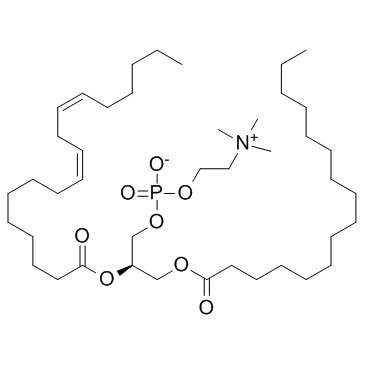Soybean phospholipid

Soybean phospholipid structure
|
Common Name | Soybean phospholipid | ||
|---|---|---|---|---|
| CAS Number | 8002-43-5 | Molecular Weight | 758.060 | |
| Density | 1.0305 g/cm3 (20ºC) | Boiling Point | N/A | |
| Molecular Formula | C42H80NO8P | Melting Point | 236.1ºC | |
| MSDS | Chinese USA | Flash Point | 57 °C | |
| Symbol |


GHS06, GHS08 |
Signal Word | Danger | |
Use of Soybean phospholipidLecithin is regarded as a safe, conventional phospholipid source. Phospholipids are reported to alter the fatty acid composition and microstructure of the membranes in animal cells. |
| Name | phosphatidylcholine(1+) |
|---|---|
| Synonym | More Synonyms |
| Description | Lecithin is regarded as a safe, conventional phospholipid source. Phospholipids are reported to alter the fatty acid composition and microstructure of the membranes in animal cells. |
|---|---|
| Related Catalog | |
| In Vitro | After culturing in MRS broth with 0.2 to 1.0% soy Lecithin, the survival rate of harvested cells increases significantly (P<0.05) in the 0.3% bile challenge compare with the no added soy Lecithin group. The cells incubated with 0.6% soy Lecithin are able to grow in an MRS broth with a higher bile salt content. The cell surface hydrophobicity is enhanced and the membrane integrity in the bile challenge increases after culturing with soy Lecithin. A shift in the fatty acid composition is also observed, illustrating the cell membrane changes in the soy Lecithin culture[1]. |
| Cell Assay | MRS broths are supplemented with soy Lecithin concentrations of 0, 0.2, 0.4, 0.6, 0.8 and 1.0%. Each broth is inoculated with a tested strain culture (2%, v/v) and anaerobically incubated at 37°C for 20 h. After incubation, the bacterium cells are harvested by centrifugation at 8000 g for 10 min at 4°C and washed twice in PBS (pH 6.5) plus ethanol (5%, v/v). Strain bile resistance is assessed. The numbers of viable cells are counted by the pouring plate method, and each batch is tested three times[1]. |
| References |
| Density | 1.0305 g/cm3 (20ºC) |
|---|---|
| Melting Point | 236.1ºC |
| Molecular Formula | C42H80NO8P |
| Molecular Weight | 758.060 |
| Flash Point | 57 °C |
| Exact Mass | 757.562134 |
| PSA | 121.00000 |
| LogP | 10.90 |
| InChIKey | JLPULHDHAOZNQI-JLOPVYAASA-N |
| SMILES | CCCCCC=CCC=CCCCCCCCC(=O)OC(COC(=O)CCCCCCCCCCCCCCC)COP(=O)([O-])OCC[N+](C)(C)C |
| Storage condition | 2-8°C |
| Stability | Stable, but light, heat, moisture and air-sensitive. Incompatible with strong oxidizing agents. |
| Symbol |


GHS06, GHS08 |
|---|---|
| Signal Word | Danger |
| Hazard Statements | H302-H315-H319-H331-H336-H351-H361d-H372 |
| Precautionary Statements | P201-P261-P304 + P340 + P312-P305 + P351 + P338-P308 + P313-P403 + P233 |
| Personal Protective Equipment | Eyeshields;Faceshields;full-face respirator (US);Gloves;multi-purpose combination respirator cartridge (US);type ABEK (EN14387) respirator filter |
| Hazard Codes | T: Toxic;Xn: Harmful;F: Flammable; |
| Risk Phrases | 11-48/20/22-40-38-22-36/37/38-46-45-48/20/21/22 |
| Safety Phrases | 7-16-24/25-36/37-45-36/37/39-26-53 |
| RIDADR | UN 2810 6.1/PG 2 |
| WGK Germany | 3 |
| RTECS | OG7565000 |
| Packaging Group | III |
| Hazard Class | 3 |
| HS Code | 2923200000 |
| HS Code | 2923200000 |
|---|
|
Liposome encapsulated soy lecithin and cholesterol can efficiently replace chicken egg yolk in human semen cryopreservation medium.
Syst. Biol. Reprod. Med. 60(3) , 183-8, (2014) Cryopreservation of spermatozoa plays a significant role in reproductive medicine and fertility preservation. Chicken egg yolk is used as an extender in cryopreservation of human spermatozoa using gly... |
|
|
The kinetics of the swelling process and the release mechanisms of Coriandrum sativum L. essential oil from chitosan/alginate/inulin microcapsules.
Food Chem. 195 , 39-48, (2015) The encapsulation by spray drying method of coriander essential oil (CEO) in various materials (chitosan, alginate, chitosan/alginate, chitosan/inulin) was studied. The viscoelastic properties of the ... |
|
|
Patch clamp characterization of the effect of cardiolipin on MscS of E. coli.
Eur. Biophys. J. 44 , 567-76, (2015) The bacterial mechanosensitive channels MscS and MscL are gated by an increase in membrane tension when the bacterium experiences hypoosmotic shock. It has been well established that membrane lipids m... |
| (2R)-2-[(9Z,12Z)-9,12-Octadecadienoyloxy]-3-(palmitoyloxy)propyl 2-(trimethylammonio)ethyl phosphate |
| kelecin |
| Ethanaminium, 2-[[hydroxy[(2R)-3-[(1-oxohexadecyl)oxy]-2-[[(9Z,12Z)-1-oxo-9,12-octadecadien-1-yl]oxy]propoxy]phosphinyl]oxy]-N,N,N-trimethyl-, inner salt |
| Lecithin |
| 1-hexadecanoyl-2-(9Z,12Z-octadecadienoyl)-sn-glycero-3-phosphocholine |
| EINECS 232-307-2 |
| Alcolec-S |
| froM Egg |
| Ethanaminium, 2-[[hydroxy[3-[(1-oxohexadecyl)oxy]-2-[[(9Z,12Z)-1-oxo-9,12-octadecadien-1-yl]oxy]propoxy]phosphinyl]oxy]-N,N,N-trimethyl-, inner salt |
| granulestin |
| 2-[(9Z,12Z)-9,12-Octadecadienoyloxy]-3-(palmitoyloxy)propyl 2-(trimethylammonio)ethyl phosphate |
| Phospholutein |

